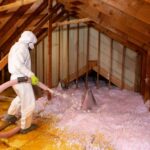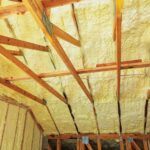As a homeowner, understanding how to spot roof leaks around flashing is vital to maintaining the integrity of your home. Roof leaks can lead to extensive damage if not addressed promptly. In this guide, we’ll explore the key indicators of roof leaks around flashing and provide tips on how to prevent them from causing further damage.
Flashing is an essential component of your roofing system. It is a thin material, usually made of metal, that directs water away from critical areas such as chimneys, vents, and valleys. When flashing fails, it can allow water to penetrate your roof, leading to leaks and significant damage. Therefore, learning how to identify these leaks early is crucial.

Understanding Roof Flashing
Before diving into how to spot roof leaks around flashing, it’s important to understand what flashing is and its role in your roofing system. Flashing is installed at joints and edges where the roof meets other structures, such as chimneys, walls, and skylights. Its primary function is to create a watertight barrier, preventing water from seeping into these vulnerable areas.
Types of Roof Flashing
There are several types of roof flashing, each designed for specific applications:
- Step Flashing: Used along the edges of chimneys and walls.
- Valley Flashing: Installed in roof valleys where two roof slopes meet.
- Drip Edge Flashing: Placed along the roof’s edge to direct water away from the fascia.
- Vent Pipe Flashing: Used around vent pipes to prevent water intrusion.
Common Causes of Roof Leaks Around Flashing
Understanding the common causes of roof leaks around flashing can help you identify potential problems early. Some of the most common causes include:
Poor Installation
Improperly installed flashing is a leading cause of roof leaks. If the flashing is not secured correctly, water can seep through gaps and cause leaks. It’s important to ensure that flashing is installed by a professional to prevent such issues.
Weather Damage
Severe weather conditions, such as heavy rain, strong winds, and hail, can damage flashing over time. This damage can lead to gaps and openings that allow water to penetrate your roof.
Corrosion and Rust
Flashing made of metal is susceptible to corrosion and rust, especially in areas with high humidity or salt exposure. Over time, rust can weaken the flashing, leading to leaks.
Age and Wear
Like any other component of your home, flashing can wear out over time. Regular inspections can help identify signs of wear and age, allowing you to address issues before they become significant problems.
Signs of Roof Leaks Around Flashing
Recognizing the signs of roof leaks around flashing is crucial for preventing further damage. Here are some indicators to watch for:
Water Stains on Ceilings and Walls
One of the most apparent signs of a roof leak is water stains on your ceilings and walls. These stains are often brown or yellow and indicate that water is seeping through your roof.
Damp or Moldy Smell
If you notice a persistent damp or moldy smell in your home, it could be a sign of a roof leak. Mold thrives in moist environments, and a leak around flashing can create the perfect conditions for mold growth.
Visible Drips or Moisture
During heavy rain, you may notice visible drips or moisture around areas where flashing is installed. This is a clear sign that water is penetrating your roof and needs immediate attention.
How to Inspect for Roof Leaks Around Flashing
Regular roof inspections are key to identifying and addressing leaks around flashing. Here’s how you can conduct a thorough inspection:
Visual Inspection
Start with a visual inspection of your roof from the ground. Look for any visible damage, such as missing or damaged shingles, gaps in flashing, or rusted areas. Use a pair of binoculars for a closer look.
Interior Inspection
Inspect the interior of your home for signs of leaks, such as water stains, mold, or dampness. Pay close attention to areas around chimneys, skylights, and vents.
Check Attic and Crawl Spaces
Access your attic or crawl spaces to check for signs of water intrusion. Look for damp insulation, mold, or water stains on the rafters and ceiling.
Steps to Repair Roof Leaks Around Flashing
If you identify a leak around flashing, it’s important to address it promptly to prevent further damage. Here are the steps to repair roof leaks around flashing:
Remove Damaged Shingles
If the leak is caused by damaged shingles around the flashing, carefully remove the affected shingles to expose the flashing.
Inspect and Repair Flashing
Inspect the flashing for any damage, such as cracks, gaps, or rust. Replace damaged flashing and seal any gaps with roofing cement or sealant.
Replace Shingles
Once the flashing is repaired, replace the removed shingles with new ones. Ensure they are properly aligned and secured to prevent future leaks.
Prevention Tips for Roof Leaks Around Flashing
Preventing roof leaks around flashing involves regular maintenance and inspections. Here are some prevention tips:
Regular Inspections
Conduct regular roof inspections to identify potential issues early. Pay close attention to areas around flashing and address any problems promptly.
Professional Maintenance
Hire a professional roofing contractor to perform regular maintenance on your roof. They can identify and address issues that may not be visible to the untrained eye.
Use Quality Materials
Ensure that your roof and flashing are made of high-quality materials that can withstand harsh weather conditions. Investing in quality materials can prevent future leaks and extend the lifespan of your roof.
Conclusion
Knowing how to spot roof leaks around flashing is essential for maintaining the integrity of your home. By understanding the common causes and signs of leaks, conducting regular inspections, and taking preventative measures, you can protect your home from water damage and extend the life of your roof.
For more information on roof maintenance, you can check out this guide on prolonging the lifespan of your roof.

FAQs About Roof Leaks Around Flashing
What causes roof leaks around flashing?
Roof leaks around flashing are often caused by poor installation, weather damage, corrosion, or wear and tear over time.
How can I prevent roof leaks around flashing?
Regular inspections, professional maintenance, and using high-quality materials can help prevent roof leaks around flashing.
When should I hire a professional for roof leaks?
If you notice signs of roof leaks, such as water stains or mold, it’s best to hire a professional to assess and repair the damage.
This article contains affiliate links. We may earn a commission at no extra cost to you.







